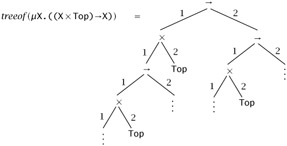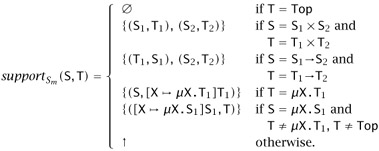21.8 -Types
|
| < Free Open Study > |
|
21.8 μ-Types
This section develops the finite μ-notation, defines subtyping on μ-expressions, and establishes the correspondence between this notion of subtyping and the subtyping on tree types.
21.8.1 Definition
Let X range over a fixed countable set {X1, X2,...} of type variables. The set ![]() of raw μ-types is the set of expressions defined by the following grammar:
of raw μ-types is the set of expressions defined by the following grammar:
-
T
::=
X
Top
T × T
T→T
μX.T
The syntactic operator μ is a binder, and gives rise, in the standard way, to notions of bound and free variables, closed raw μ-types, and equivalence of raw μ-types up to renaming of bound variables. FV(T) denotes the set of free variables of a raw μ-type T. The capture-avoiding substitution [X ↦ S]T of a raw μ-type S for free occurrences of X in a raw μ-type T is defined as usual.
Raw μ-types have to be restricted a little to achieve a tight correspondence with regular trees: we want to be able to "read off" a tree type as the infinite unfolding of a given μ-type, but there are raw μ-types that cannot be reasonably interpreted as representations of tree types. These types have subexpressions of the form μX.μX1...μXn.X, where the variables X1 through Xn are distinct from X. For example, consider T = μX.X. Unfolding of T gives T again, so we cannot read off any tree by unfolding T. This leads us to the following restriction.
21.8.2 Definition
A raw μ-type T is contractive if, for any subexpression of T of the form μX.μX1...μXn .S, the body S is not X. Equivalently, a raw μ-type is contractive if every occurrence of a μ-bound variable in the body is separated from its binder by at least one → or ×.
A raw μ-type is called simply a μ-type if it is contractive. The set of μ-types is written Tm.
When T is a μ-type, we write μ-height(T) for the number of μ-bindings at the front of T.
The common understanding of μ-types as finite notation for infinite regular tree types is formalized by the following function.
21.8.3 Definition
The function treeof, mapping closed μ-types to tree types, is defined inductively as follows:
-
treeof (Top)(*)
=
Top
treeof (T1→T2)(*)
=
→
treeof (T1→T2)(i,π)
=
treeof(Ti)(π)
treeof(T1 × T2)(*)
=
×
treeof (T1 × T2)(i,π)
=
treeof(Ti)(π)
treeof (μX.T)(π)
=
treeof([X ↦ μX.T]T)(π)
To verify that this definition is proper (i.e., exhaustive and terminating), note the following:
-
Every recursive use of treeof on the right-hand side reduces the lexicographic size of the pair(|π|, μ-height(T)):the cases for S→T and S × T reduce |π| and the case for μX.T preserves |π| but reduces μ-height(T).
-
All recursive calls preserve contractiveness and closure of the argument types. In particular, the type μX.T is contractive and closed iff its unfolding [X ↦ μX.]T is. This justifies the unfolding step in the definition of treeof (μX.T).
The treeof function is lifted to pairs of types by defining treeof (S, T) = (treeof (S), treeof (T)).
An sample application of treeof to a μ-type is shown in Figure 21-3.

Figure 21-3: Sample treeof Application
The subtype relation for tree types was defined in §21.3 as the greatest fixed point of the generating function S. In the present section, we extended the syntax of types with μ-types, whose behavior is intuitively described by the rules of (right and left, correspondingly) μ-folding:
![]()
Formally, we define subtyping for μ-types by giving a generating function Sm, with three clauses identical to the definition of S and two additional clauses corresponding to the μ-folding rules.
21.8.4 Definition
Two μ-types S and T are said to be in the subtype relation if (S, T) Î vSm, where the monotone function Sm Î P (Tm × Tm) → P(Tm × Tm) is defined by:
-
Sm(R)
=
{(S, Top) | S Î Tm}
È
{(S1 × S2, T1 × T2) | (S1, T1), (S2, T2) Î R}
È
{S1→S2, T1→T2) | (T1, S1), (S2, T2) Î R}
È
{S, μX.T) | (S, [X → μX.T]T) Î R}
È
{(μX.S, T) | ([X → μX.S]S, T) Î R, T ≠ Top, and T ≠ μY.T1}.
Note that this definition does not embody precisely the μ-folding rules above: we have introduced an asymmetry between its final and penultimate clauses to make it invertible (otherwise, the clauses would overlap). However, as the next exercise shows, Sm generates the same subtype relation as the more natural generating function[4] Sd whose clauses exactly correspond to the inference rules.
21.8.5 Exercise [⋆⋆⋆]
Write down the function Sd mentioned above, and demonstrate that it is not invertible. Prove that vSd = vSm.
The generating function Sm is invertible because the corresponding support function is well-defined:

The subtype relation on μ-types so far has been introduced independently of the previously defined subtyping on tree types. Since we think of μ-types as just a way of representing regular types in a finite form, it is necessary to ensure that the two notions of subtyping correspond to each other. The next theorem (21.8.7) establishes this correspondence. But first, we need a technical lemma.
21.8.6 Lemma
Suppose that R ⊆ Tm × Tm is Sm-consistent. For any (S, T) Î R, there is some (S′, T′) Î R such that treeof (S′, T′) = treeof (S, T) and neither S′ nor T′ starts with μ.
Proof: By induction on the total number of μs at the front of S and T. If neither S nor T starts with μ, then we can take (S′, T′) = (S, T). On the other hand, if (S, T) = (S, μX.T1), then by the Sm-consistency of R, we have (S, T) Î Sm(R), so (S″, T″) = (S, [X ↦ μX.T1]T1) Î R. Since T is contractive, the result T″ of unfolding T has one fewer μ at the front than T does. By the induction hypothesis, there is some (S′, T′) Î R such that neither S′ nor T′ starts with μ and such that treeof(S″, T″) = (S′, T′). Since, by the definition of treeof, treeof (S, T) = treeof (S″, T″), the pair (S′, T′) is the one we need. The case where (S, T) = (μX.S1, T) is similar.
21.8.7 Theorem
Let (S, T) Î Tm × Tm. Then (S, T) Î vSm iff treeof (S, T) Î vS.
Proof: First, let us consider the "only if" direction-that (S, T) Î vSm implies treeof (S, T) Î vSm. Let (A, B) = treeof (S, T) Î T × T. By the coinduction principle, the result will follow if we can exhibit an S-consistent set Q Î T × T such that (A, B) Î Q. Our claim is that Q = treeof (vSm) is such a set. To verify this, we must show that (A′, B′) Î S(Q) for every (A′, B′) Î Q.
Let (S′, T′) Î vSm be a pair of μ-types such that treeof (S′, T′) = (A′, B′). By Lemma 21.8.6, we may assume that neither S′ nor T′ starts with μ. Since vSm is Sm-consistent, (S′, T′) must be supported by one of the clauses in the definition of Sm-i.e., it must have one of the following shapes.
| Case: | (S′, T′) = (S′, Top) |
Then B′ = Top, and (A′, B′) Î S(Q) by the definition of S.
| Case: | (S′, T′) = (S1 × S2, T1 × T2) | with | (S1, T1), (S2, T2) Î vSm |
By the definition of treeof, we have B′ = treeof(T′)= B1 × B2, where each Bi = treeof(Ti). Similarly, A′ = A1 × A2, where Ai = treeof (Si). Applying treeof to these pairs gives (A1, B1), (A2, B2) Î Q. But then, by the definition of S, we have (A, B) = (A1 × A2, B1 × B2) Î S(Q).
| Case: | (S′, T′) = (S1→S2, T1→T2) | with | (T1, S1), (S2, T2) Î vSm Similar. |
Next, let us check the "if" direction of the theorem-that treeof (S, T) Î vS implies (S, T) Î vSm. By the coinduction principle, it suffices to exhibit an Sm-consistent set R Î Tm × Tm with (S, T) Î R. We claim that R = {(S′ T′) Î Tm × Tm | treeof(S′, T′) Î vS}. Clearly, (S, T) Î R. To finish the proof, we must now show that (S′, T′) Î R implies (S′, T′) Î Sm(R).
Note that, since vS is S-consistent, any pair (A′, B′) Î vS must have one of the forms (A′, Top), (A1 × A2, B1 × B2), or (A1→A2, B1→B2). From this and the definition of treeof , we see that any pair (S′ T′) Î R must have one of the forms (S′, Top), (S1 × S2, T1 × T2), (S1→S2, T1→T2), (S′, μX.T1), or (μX.S1, T′). We consider each of these cases in turn.
| Case: | (S′, T′) = (S′, Top) |
Then (S′, T′) Î Sm(R) immediately, by the definition of Sm.
| Case: | (S′, T′) = (S1 × S2, T1 × T2) |
Let (A′, B′) = treeof (S′ T′). Then (A′, B′) = (A1 × A2, B1 × B2), with Ai = treeof (Si) and Bi = treeof(Ti). Since (A′, B′) Î vS, the S-consistency of vS implies that (Ai, Bi) Î vS, which in turn yields (Si, Ti) Î R, by the definition of R. The definition of Sm yields (S′, T′) = (S1 × S2, T1 × T2) Î Sm(R).
| Case: | (S′, T′) = (S1→S2, T1→T2) |
Similar.
| Case: | (S′, T′) = (S′, μX.T1) |
Let T″ = [X ↦ μX.T1]T1. By definition, treeof (T″) = treeof (T′). Therefore, by the definition of R, we have (S′, T″) Î R, and so (S′, T′) Î Sm(R), by the definition of Sm.
| Case: | (S′, T′) = (μX.S1, T′) |
If T′ = Top or T′ starts with μ, then one of the cases above applies; otherwise, the argument is similar to the previous one.
The correspondence established by the theorem is a statement of soundness and completeness of subtyping between μ-types, as defined in this section, with respect to the ordinary subtype relation between infinite tree types, restricted to those tree types that can be represented by finite μ-expressions.
[4]The "d" in Sd is a reminder that the function is based on the "declarative" inference rules for μ-folding, in contrast to the "algorithmic" versions used in Sm.
|
| < Free Open Study > |
|
EAN: 2147483647
Pages: 262